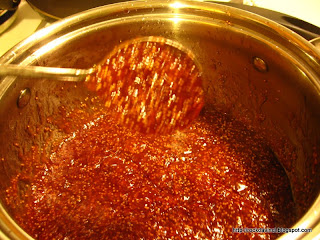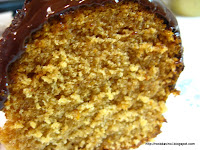I almost forgot to share this. My mother had a bounty of fresh figs this year. Last year, I peeled them and dried them Hoping to make Cucidatti. This year, I made the Fig Newtons. There are some great looking Fig Newtons by other bloggers where I got the tips from.
Here is my result:
I wished I posted this back in August when I made them. Now I forgot if I used the recipe link Weelicious to Mehan'sKitchen.blogspot.com or thefauxmartha.com
My hand notes got several recipes and scribbling, but I think it's the Mehan'sKitchen.blogspot.com recipe I used. The big difference is that I used fresh figs rather than 12 oz dried fig.
Ingredients for Dough:
6 Tbsp Soft Butter
1/3 C Sugar (instead of 1/2 C as in the original recipe)
1 large egg
1 tsp vanilla
1-1/2 C flour
Method:
Sift flour, then, measure 1-1/2 Cup. Set aside.
Cream 6 Tbsp soft butter with 1/3 C sugar for 2 minutes.
Add 1 large egg, and 1 tsp vanilla and beat a couple more minutes or less to incoroporate egg into butter mixture.
Add flour. Roll into 12 inch logs.
Chill in refrigerator rolled in plastic wrap until the Fig paste is ready.
When the fig paste is ready: (Recipe below)
Over a parchment paper, Roll out into 12 x 8 inch. Or after rolling it out, place on a parchment paper.
Each piece of dough is 4 inches wide. Fill 2" inside with an inch border on each side.<<< I think I eyeballed this section of the instruction to make mine.
Add fig paste into pastry bag. Squeeze the paste out without any tips. This works out better as the paste is very sticky and thick.
Squeeze the prepared fig paste in center.
One side at a time, lift each side the parchment paper over and fold the dough over the fig paste to envelope it. Form the dough into shape with the help of parchment paper.
Transfer over to baking sheet and remove the parchment paper.
Bake at 350'F for 20 min - a hint of browning at the bottom edge.
This one is actually already a bit browner than desired at the edge. Make sure your is not like this.
Gently, slice with sharp serrated knife when it is bit cooled but warm, not cold.
Enjoy!
FRESH FIG PASTE:
Gather about 40 fresh figs. Make sure that they are not over ripened. To Jar/can them, they have to be in a tip top shape and at ripening stage.
Peel figs and open the figs to make sure that they are good.
Place them in a small pot.
Add 1 cup of sugar Add a 1/8 tsp of Fresh Fruits Ascorbic Acid
Stir to mix.
Bring heat to simmer.
Cook/simmer until it starts to thicken - about 2 hours at least. Set timer to check at 1 hour and then at 30 minutes interval.
When it starts to show sign of thickening, use a heat proof spatula, for example, and start stirring to help evaporate more liquid. Set your alarm and check every 15 minutes, and stir. Pay attention not to burn at the bottom. Do not go too far away from the kitchen.
Next, Stir constantly to help the evaporation until it becomes paste.
Remove from heat and let cool.
Scrape the side of the pot with heat proof spatula.
When it starts to become a thick paste, you can see the bottom of the pot while stirring.
Do the same for rest of new fresh figs picked. Prepare mason jars - sterilize and heat seal.
After 2 to 2-1/2 hours of simmering and stirring.
Here is my result:
I wished I posted this back in August when I made them. Now I forgot if I used the recipe link Weelicious to Mehan'sKitchen.blogspot.com or thefauxmartha.com
My hand notes got several recipes and scribbling, but I think it's the Mehan'sKitchen.blogspot.com recipe I used. The big difference is that I used fresh figs rather than 12 oz dried fig.
Ingredients for Dough:
6 Tbsp Soft Butter
1/3 C Sugar (instead of 1/2 C as in the original recipe)
1 large egg
1 tsp vanilla
1-1/2 C flour
Method:
Sift flour, then, measure 1-1/2 Cup. Set aside.
Cream 6 Tbsp soft butter with 1/3 C sugar for 2 minutes.
Add 1 large egg, and 1 tsp vanilla and beat a couple more minutes or less to incoroporate egg into butter mixture.
Add flour. Roll into 12 inch logs.
Chill in refrigerator rolled in plastic wrap until the Fig paste is ready.
When the fig paste is ready: (Recipe below)
Over a parchment paper, Roll out into 12 x 8 inch. Or after rolling it out, place on a parchment paper.
Each piece of dough is 4 inches wide. Fill 2" inside with an inch border on each side.<<< I think I eyeballed this section of the instruction to make mine.
Add fig paste into pastry bag. Squeeze the paste out without any tips. This works out better as the paste is very sticky and thick.
Squeeze the prepared fig paste in center.
Transfer over to baking sheet and remove the parchment paper.
Bake at 350'F for 20 min - a hint of browning at the bottom edge.
This one is actually already a bit browner than desired at the edge. Make sure your is not like this.
Gently, slice with sharp serrated knife when it is bit cooled but warm, not cold.
Enjoy!
FRESH FIG PASTE:
Gather about 40 fresh figs. Make sure that they are not over ripened. To Jar/can them, they have to be in a tip top shape and at ripening stage.
Peel figs and open the figs to make sure that they are good.
Place them in a small pot.
Add 1 cup of sugar Add a 1/8 tsp of Fresh Fruits Ascorbic Acid
Stir to mix.
Bring heat to simmer.
Cook/simmer until it starts to thicken - about 2 hours at least. Set timer to check at 1 hour and then at 30 minutes interval.
When it starts to show sign of thickening, use a heat proof spatula, for example, and start stirring to help evaporate more liquid. Set your alarm and check every 15 minutes, and stir. Pay attention not to burn at the bottom. Do not go too far away from the kitchen.
Next, Stir constantly to help the evaporation until it becomes paste.
Remove from heat and let cool.
When it starts to become a thick paste, you can see the bottom of the pot while stirring.
Do the same for rest of new fresh figs picked. Prepare mason jars - sterilize and heat seal.
After 2 to 2-1/2 hours of simmering and stirring.










































































